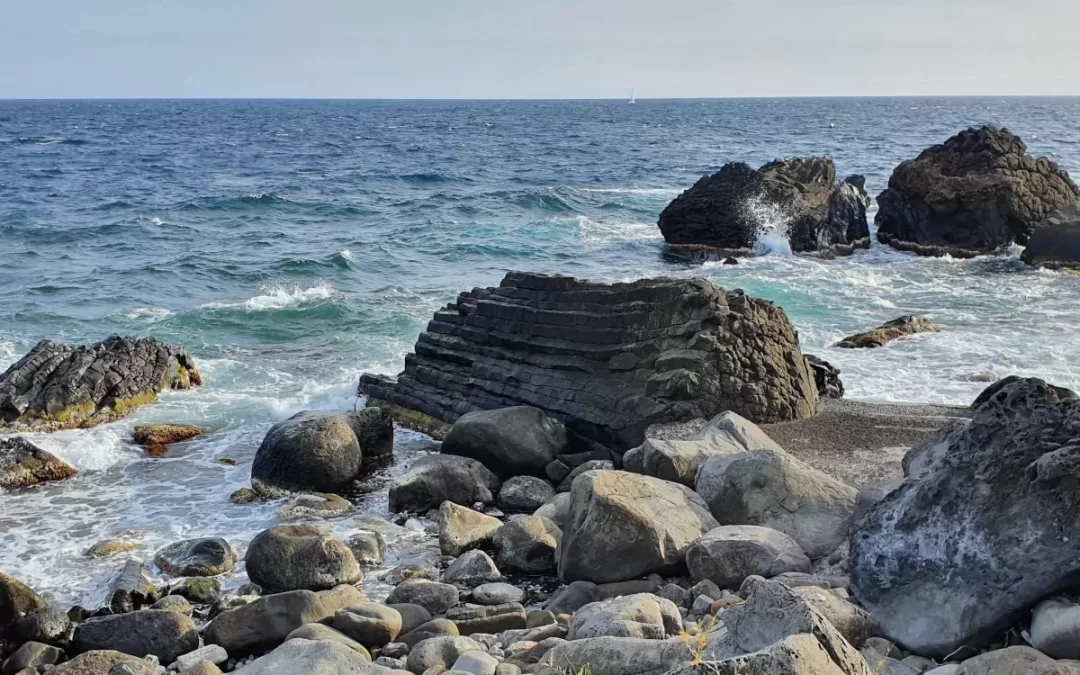We already told you in an earlier article (Lava tubes of Etna I) how Mount Etna was formed. However, how did Sicily originate?
Originally, there was sea on the site of what is now Sicily. Plate tectonics, or more precisely the fact that the African plate is sliding under the Eurasian plate (subduction), has caused the ground to rise. At first, about 5 million years ago, only a few small islets were formed, until more and more land emerged and finally mountain ranges were formed, which today we call Monti Peloritani, Nebrodi and Madonie (in the north), Iblei (in the south) and Sicani (in the west).
570,000 years ago, Sicily had almost its present form, only at the point of Etna there was a large bay in which the volcano slowly began to rise.
This plate boundary runs right through Sicily today and causes earthquakes and volcanism in this region: the Aeolian Islands in the north of Sicily are of volcanic origin, with their most famous volcano, Stromboli; in the Strait of Sicily (the strait between Sicily and Tunisia) there is an undersea volcanic massif; and of course Mount Etna as the largest and most active volcano in Europe.
Legends about the origin of Sicily
But there are also many legends surrounding the origins of Sicily. Probably the most beautiful is the following:
Once upon a time there were three nymphs who wandered the world dancing. At the most beautiful and fertile spots, they collected the things they found there: Earth, fruits, flowers, stones, … After they had travelled enough, the three nymphs stopped at a beautiful place under a bright blue sky. Their dance became faster and wilder and they threw the collected treasures down into the sea. The water opened up and a fertile, beautiful land in the shape of a triangle rose from the floods. The places where the nymphs began their dance today form the three capes at the tips of Sicily:
- Cape Lilibeo in Marsala in western Sicily,
- Cape Passero at the southeast corner,
- Cape Peloro in the northeast.
A far more dramatic story of the origins of Sicily can be found in Greek mythology; In the Gigantomachy, Apollodorus describes the battle of the Olympian gods under Zeus against the Giants (or Gigantes):
The giants were mortal giants of not very handsome stature. Her mother was Gaia, the earth itself. Besides the giants, Gaia also gave birth to the Titans, whose leader was Kronos. The children of Kronos were Zeus and his five siblings. Zeus rose up against his father and finally imprisoned him and his comrades-in-arms in the underworld (Tartarus), from which there was no escape for the Titans.
Gaia was so enraged by this that she set the giants against the Olympic gods. The battle ensued. The giants were mortal, but could not be killed by a god, only by human hands. So the gods needed the help of Heracles, a son of Zeus and a mortal woman. This one killed most of the giants in battle. One of the giants, Enkelados, fought the goddess Athena but managed to escape. The latter then took a huge rock, hurled it at the giant and buried him under it.
Today we call this rock Sicily. Enkelados is still buried under Sicily: his feet are said to be under Cape Lilibeo, his left hand under Cape Passero and his right hand under Cape Peloro. His head is buried under Etna. Sometimes he screams and struggles and tries to free himself. The result: earthquakes and a dull rumbling on Etna (we already know, of course, that the rumbling comes from explosions inside the main craters…); its fiery breath is said to be Etna’s lava.
The name Sicily
Now that we have learned so much about the origins of Sicily, let’s clarify how the island actually got its name. There is also a beautiful legend about this:
Once upon a time there was a beautiful Lebanese princess called Sicilia. An oracle has predicted a tragic fate for her: she will be killed by a monster if she does not leave her home before her 15th birthday. Therefore, they put their parents in a boat and bid her farewell. After three months at sea, the supplies on board were exhausted and the princess thought she was going to die.
Then favourable winds brought her to an island where she was stranded at the foot of a volcano. The island was full of fruits and flowers, but deserted. The princess cried from sheer loneliness until there was not a tear left, when suddenly a handsome young man appeared. He was the last of his people to be swept away by a terrible plague. The two fell in love and repopulated the island. The young man, now king of the island, named it “Sicily” after his beloved wife.
Less romantic and legendary is the following explanation: From the 15th century onwards, the B.C., the Sicilian people migrated from Italy to Sicily and populated the entire east of the island. It is not known exactly whether they displaced the original population or whether the area was deserted anyway because the original population had moved away after a volcanic eruption. In any case, the island was subsequently named after the Siculi. The people in turn take their name from one of their kings, Sikelòs.
The further origin of the name Sicily is lost in history and we will leave it at that for this time. See you next time!
